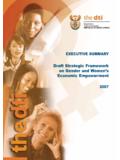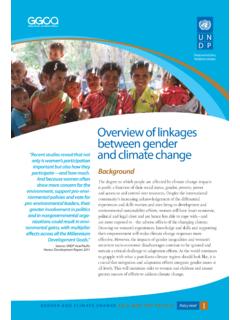Transcription of The Millennium Development Goals Report 2015
1 AsdfThe Millennium Development Goals Report 2015 UNITED NATIONSC over InsideThis Report is based on a master set of data that has been compiled by the Inter-Agency and Expert Group on MDG Indicators led by the Department of economic and Social Affairs of the United nations Secretariat, in response to the wishes of the General Assembly for periodic assessment of progress towards the MDGs. The Group comprises representatives of the international organizations whose activities include the preparation of one or more of the series of statistical indicators that were identified as appropriate for monitoring progress towards the MDGs, as reflected in the list below. A number of national statisticians and outside expert advisers also contributed. economic AnD SOCIAL COMMISSIOn FOR ASIA AnD THE PACIFICECOnOMIC AnD SOCIAL COMMISSIOn FOR WESTERn ASIA economic COMMISSIOn FOR AFRICAECOnOMIC COMMISSIOn FOR EUROPEECOnOMIC COMMISSIOn FOR LATIn AMERICA AnD THE CARIBBEAnFOOD AnD AGRICULTURE ORGAnIZATIOn OF THE UnITED nATIOnSInTERnATIOnAL LABOUR ORGAnIZATIOn InTERnATIOnAL MOnETARY FUnD InTERnATIOnAL TELECOMMUnICATIOn UnIOnInTERnATIOnAL TRADE CEnTREInTER-PARLIAMEnTARY UnIOn JOInT UnITED nATIOnS PROGRAMME On HIV/AIDS ORGAnISATIOn FOR economic CO-OPERATIOn AnD DEVELOPMEnTSECRETARIAT OF THE PACIFIC COMMUnITYTHE WORLD BAnKUnITED nATIOnS CHILDREn S FUnDUnITED nATIOnS COnFEREnCE On TRADE AnD Development UnITED nATIOnS Development PROGRAMME UnITED nATIOnS EDUCATIOnAL.
2 SCIEnTIFIC AnD CULTURAL ORGAnIZATIOnUnITED nATIOnS EnTITY FOR GEnDER EQUALITY AnD THE empowerment OF women - Un WOMEnUnITED nATIOnS EnVIROnMEnT PROGRAMME UnITED nATIOnS FRAMEWORK COnVEnTIOn On CLIMATE CHAnGEUnITED nATIOnS HIGH COMMISSIOnER FOR REFUGEES UnITED nATIOnS HUMAn SETTLEMEnTS PROGRAMMEUnITED nATIOnS InDUSTRIAL Development ORGAnIZATIOnUnITED nATIOnS POPULATIOn FUnD WORLD HEALTH ORGAnIZATIOnWORLD TRADE ORGAnIZATIOnThe Millennium Development Goals Report 2015asdfUnited nationsnew York, 2015 Foreword | 3 ForewordThe global mobilization behind the Millennium Development Goals has produced the most successful anti-poverty movement in history. The landmark commitment entered into by world leaders in the year 2000 to spare no effort to free our fellow men, women and children from the abject and dehumanizing conditions of extreme poverty was translated into an inspiring framework of eight Goals and, then, into wide-ranging practical steps that have enabled people across the world to improve their lives and their future prospects.
3 The MDGs helped to lift more than one billion people out of extreme poverty, to make inroads against hunger, to enable more girls to attend school than ever before and to protect our planet. They generated new and innovative partnerships, galvanized public opinion and showed the immense value of setting ambitious Goals . By putting people and their immediate needs at the forefront, the MDGs reshaped decision-making in developed and developing countries for all the remarkable gains, I am keenly aware that inequalities persist and that progress has been uneven. The world s poor remain overwhelmingly concentrated in some parts of the world. In 2011, nearly 60 per cent of the world s one billion extremely poor people lived in just five countries. Too many women continue to die during pregnancy or from childbirth-related complications. Progress tends to bypass women and those who are lowest on the economic ladder or are disadvantaged because of their age, disability or ethnicity.
4 Disparities between rural and urban areas remain pronounced. Experiences and evidence from the efforts to achieve the MDGs demonstrate that we know what to do. But further progress will require an unswerving political will, and collective, long-term effort. We need to tackle root causes and do more to integrate the economic , social and environmental dimensions of sustainable Development . The emerging post-2015 Development agenda, including the set of Sustainable Development Goals , strives to reflect these lessons, build on our successes and put all countries, together, firmly on track towards a more prosperous, sustainable and equitable world. Reflecting on the MDGs and looking ahead to the next fifteen years, there is no question that we can deliver on our shared responsibility to put an end to poverty, leave no one behind and create a world of dignity for Ki-moon Secretary-General, United Nations4 | The Millennium Development Goals Report 2015 OverviewAt the beginning of the new Millennium , world leaders gathered at the United Nations to shape a broad vision to fight poverty in its many dimensions.
5 That vision, which was translated into eight Millennium Development Goals (MDGs), has remained the overarching Development framework for the world for the past 15 years. As we reach the end of the MDG period, the world community has reason to celebrate. Thanks to concerted global, regional, national and local efforts, the MDGs have saved the lives of millions and improved conditions for many more. The data and analysis presented in this Report prove that, with targeted interventions, sound strategies, adequate resources and political will, even the poorest countries can make dramatic and unprecedented progress. The Report also acknowledges uneven achievements and shortfalls in many areas. The work is not complete, and it must continue in the new Development efforts have resulted in profound achievementsGoal 1: EradicatE ExtrEmE povErty and hunGEr Extreme poverty rate in developing countries47%1990201514%19901,926 million19991,751 million2015836 millionGlobal number of extreme poor47%1990201514%19901,926 million19991,751 million2015836 million Extreme poverty has declined significantly over the last two decades.
6 In 1990, nearly half of the population in the developing world lived on less than $ a day; that proportion dropped to 14 per cent in 2015. Globally, the number of people living in extreme poverty has declined by more than half, falling from billion in 1990 to 836 million in 2015. Most progress has occurred since 2000. The number of people in the working middle class living on more than $4 a day has almost tripled between 1991 and 2015. This group now makes up half the workforce in the developing regions, up from just 18 per cent in 1991. The proportion of undernourished people in the developing regions has fallen by almost half since 1990, from per cent in 1990 1992 to per cent in 2014 2: achiEvE univErsal primary EducationGlobal out-of-school children of primary school age20002015100million 57 million020%40%60%80%52%199060%200080%201 5 Primary school net enrolment rate in sub-Saharan Africa20002015100million 57 million020%40%60%80%52%199060%200080%201 5 The primary school net enrolment rate in the developing regions has reached 91 per cent in 2015, up from 83 per cent in 2000.
7 The number of out-of-school children of primary school age worldwide has fallen by almost half, to an estimated 57 million in 2015, down from 100 million in 2000. Sub-Saharan Africa has had the best record of improvement in primary education of any region since the MDGs were established. The region achieved a 20 percentage point increase in the net enrolment rate from 2000 to 2015, compared to a gain of 8 percentage points between 1990 and 2000. The literacy rate among youth aged 15 to 24 has increased globally from 83 per cent to 91 per cent between 1990 and 2015. The gap between women and men has | 5 Goal 3: promotE GEndEr Equality and EmpowEr women Primary school enrolment ratio in Southern Asia199010074103100201590% of countries have more women in parliament since 1995 1990100741031002015 Many more girls are now in school compared to 15 years ago.
8 The developing regions as a whole have achieved the target to eliminate gender disparity in primary, secondary and tertiary education. In Southern Asia, only 74 girls were enrolled in primary school for every 100 boys in 1990. Today, 103 girls are enrolled for every 100 boys. women now make up 41 per cent of paid workers outside the agricultural sector, an increase from 35 per cent in 1990. Between 1991 and 2015, the proportion of women in vulnerable employment as a share of total female employment has declined 13 percentage points. In contrast, vulnerable employment among men fell by 9 percentage points. women have gained ground in parliamentary representation in nearly 90 per cent of the 174 countries with data over the past 20 years. The average proportion of women in parliament has nearly doubled during the same period. Yet still only one in five members are 4: rEducE child mortalityGlobal number of deaths of children under five million6million2015020%40%60%80%100%73%2 00084%2013 Global measles vaccine coverage million6million2015020%40%60%80%100%73%2 00084%2013 The global under-five mortality rate has declined by more than half, dropping from 90 to 43 deaths per 1,000 live births between 1990 and 2015.
9 Despite population growth in the developing regions, the number of deaths of children under five has declined from million in 1990 to almost 6 million in 2015 globally. Since the early 1990s, the rate of reduction of under-five mortality has more than tripled globally. In sub-Saharan Africa, the annual rate of reduction of under-five mortality was over five times faster during 2005 2013 than it was during 1990 1995. Measles vaccination helped prevent nearly million deaths between 2000 and 2013. The number of globally reported measles cases declined by 67 per cent for the same period. About 84 per cent of children worldwide received at least one dose of measles-containing vaccine in 2013, up from 73 per cent in 2000. 6 | The Millennium Development Goals Report 2015 Goal 5: Improve maternal HealtH Global maternal mortality ratio (deaths per 100,000 live births)50%60%70%80%2015199059%71%1990380 20003302013210 Global births attended by skilled health personnel 50%60%70%80%2014199059%71%19903802000330 2013210 Since 1990, the maternal mortality ratio has declined by 45 per cent worldwide, and most of the reduction has occurred since 2000.
10 In Southern Asia, the maternal mortality ratio declined by 64 per cent between 1990 and 2013, and in sub-Saharan Africa it fell by 49 per cent. More than 71 per cent of births were assisted by skilled health personnel globally in 2014, an increase from 59 per cent in 1990. In Northern Africa, the proportion of pregnant women who received four or more antenatal visits increased from 50 per cent to 89 percent between 1990 and 2014. Contraceptive prevalence among women aged 15 to 49, married or in a union, increased from 55 per cent in 1990 worldwide to 64 per cent in 6: Combat HIv/aIDS, malarIa anD otHer DISeaSeS Global antiretroviral therapy million2014 ART900 millionNumber of insecticide-treated mosquito nets delivered in sub-Saharan Africa, 2004 million2014 ART900 million New HIV infections fell by approximately 40 per cent between 2000 and 2013, from an estimated million cases to million.












